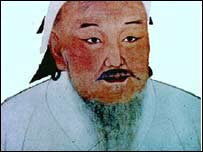| |
| The Daily
Telegraph |
| December 30, 2006 |
| By Graeme Baker |
 He
swept all before him and subjugated much of the known world. But
now, almost 800 years after his death, Genghis Kahn is embroiled
in another war as the Chinese attempt to adopt the Mongol king
as their own national hero. He
swept all before him and subjugated much of the known world. But
now, almost 800 years after his death, Genghis Kahn is embroiled
in another war as the Chinese attempt to adopt the Mongol king
as their own national hero.
In stark contrast to Mao Tse-tung, who insisted Genghis Khan was
only fit to fire arrows at birds, Communist officials and
historians now say he represents the essence of new China -- a
unifying force for a strident land of many ethnic minorities.
"We define him as a great man of the Chinese people, a hero of
the Mongolian nationality, and a giant in world history," said
Guo Wurong, the manager of the new Genghis Khan "mausoleum" in
China's Inner Mongolia province.
"Genghis Khan was certainly Chinese," he added.
The mausoleum was built on a spot the Mongol leader was said to
have passed on his way to his final war in 1227, and holds
artifacts including his bow and saddle.
But the buildings resemble many Chinese imperial tombs, drawing
criticism for historical inaccuracy.
And recent Mongolian festivals of riding, shooting and
wrestling, once banned but now subsidized by the Chinese state,
have been "communized," according to one Mongolian official who
did not wish to be named.
Such rewriting of history has raised the hackles of Mongolians,
both in the independent outer Mongolian state and inside China.
They see the attempt to claim their national icon as part of a
Chinese plan to expand influence.
Promoting Genghis Khan as Chinese also helps promote the party
line that Inner Mongolia is an important part of China, despite
the fact that many ethnic Mongols still yearn for independence.
Many remember the Cultural Revolution, when, according to
reports, between 10,000 and 17,000 died in the terror, 87,000
were crippled and 346,000 persecuted.
Professor Baildugqi, an expert on Mongolian history at the Inner
Mongolia University, said new Chinese commemorations of Genghis
Khan went against all that he was.
"You cannot use the methods of the (Chinese) interior to
commemorate Genghis and his culture," he said.
The official justification rests on the view that Genghis Khan
was Chinese because his successors ruled as Chinese emperors,
and there are many Mongolians now living in China. But it is a
view dismissed by many Mongols.
On a popular website on such issues, one contributor wrote: "Now
there are quite a few Mongolians in China, and they have Chinese
citizenship.
"But that does not make Mongolians (of the times of Genghis)
Chinese.
"If your grandson moves to the U.S. and becomes a U.S. citizen,
that will not mean that you and your dad were Americans."
Calling Genghis Khan a Chinese hero has also upset some inside
China. Many Chinese retain the view of Mao that he was no more
than a barbarian warlord.
For more
about China's sinification of Chinggis Khan see:
Hunting Chinggis
Khan's Skull and Soul: Inner Asian Frontiers of Historical
Ideology and Racial Imagination |





